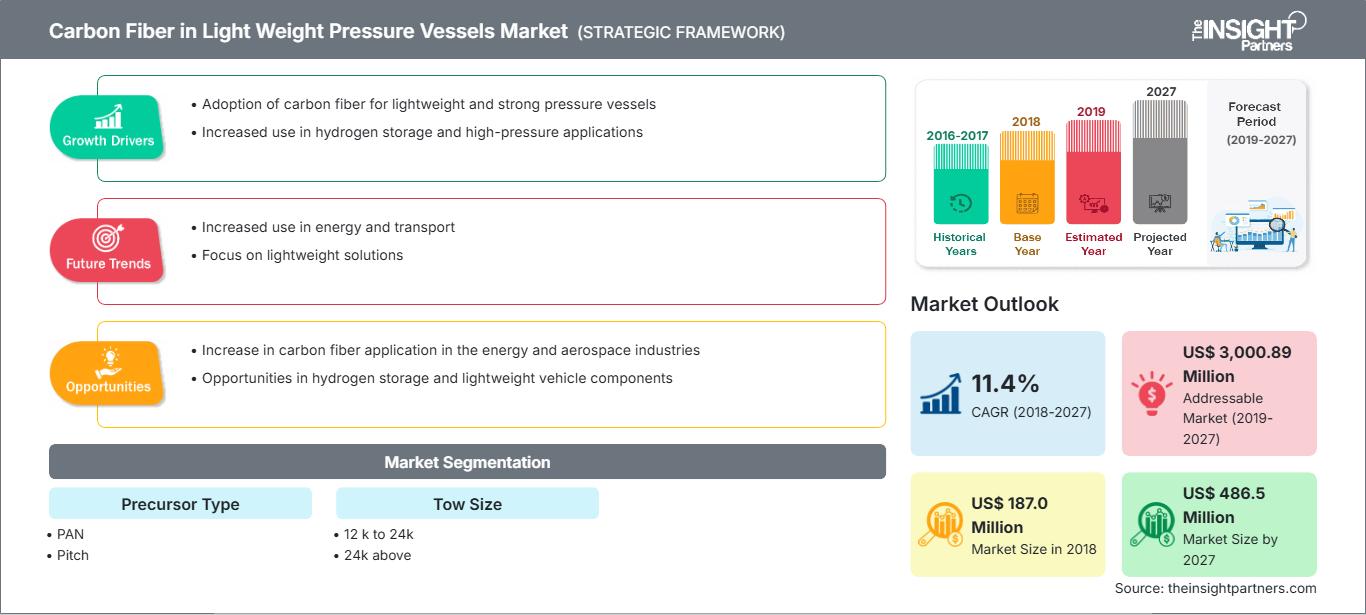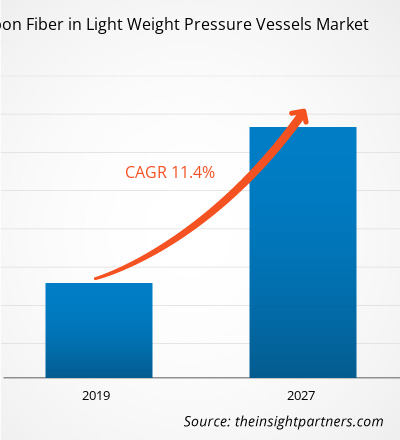Le marché mondial des récipients sous pression légers en fibre de carbone représentait 187,0 millions de dollars américains en 2018 et devrait croître à un TCAC de 11,4 % au cours de la période de prévision 2019-2027, pour atteindre 486,5 millions de dollars américains d'ici 2027.
La région APAC est la région qui connaît la croissance la plus rapide pour les récipients sous pression à base de fibre de carbone, en raison de l'augmentation de la population et des préoccupations environnementales croissantes des gouvernements de pays comme l'Inde, la Chine et le Japon, ainsi que de l'accent croissant mis sur les véhicules au GNC économes en énergie et respectueux de l'environnement. De plus, la demande croissante de l'industrie automobile devrait également stimuler la croissance du marché de la fibre de carbone pour les récipients sous pression légers dans la région.
Aperçu du marché : La demande croissante des applications automobiles et industrielles offre une opportunité de croissance pour le marché de la fibre de carbone pour les récipients sous pression légers.
La fibre de carbone offre un module et une résistance spécifique élevés, une résistance élevée à la fatigue, une rigidité élevée, une capacité de résistance à la pression élevée, un faible coefficient de dilatation thermique, une résistance à la corrosion et d'autres propriétés avantageuses, ce qui la rend utile dans les récipients sous pression pour l'automobile et d'autres applications industrielles. De plus, la demande croissante de matériaux légers, ainsi que les initiatives gouvernementales visant à réduire les émissions de gaz nocifs et à accroître le rendement énergétique, devraient stimuler le marché de la fibre de carbone pour les récipients sous pression légers dans les applications automobiles.
Personnalisez ce rapport en fonction de vos besoins
Vous bénéficierez d’une personnalisation sur n’importe quel rapport - gratuitement - y compris des parties de ce rapport, ou une analyse au niveau du pays, un pack de données Excel, ainsi que de profiter d’offres exceptionnelles et de réductions pour les start-ups et les universités
Fibre de carbone sur le marché des récipients sous pression légers: Perspectives stratégiques

- Obtenez les principales tendances clés du marché de ce rapport.Cet échantillon GRATUIT comprendra une analyse de données, allant des tendances du marché aux estimations et prévisions.
L'utilisation croissante de réservoirs sous pression en fibre de carbone dans les véhicules à pile à combustible créera des opportunités de croissance pour le marché mondial des réservoirs sous pression légers en fibre de carbone.
Vous bénéficierez d’une personnalisation sur n’importe quel rapport - gratuitement - y compris des parties de ce rapport, ou une analyse au niveau du pays, un pack de données Excel, ainsi que de profiter d’offres exceptionnelles et de réductions pour les start-ups et les universités
Fibre de carbone sur le marché des récipients sous pression légers: Perspectives stratégiques

- Obtenez les principales tendances clés du marché de ce rapport.Cet échantillon GRATUIT comprendra une analyse de données, allant des tendances du marché aux estimations et prévisions.
Le marché mondial des réservoirs sous pression légers en fibre de carbone devrait connaître une demande croissante de réservoirs étanches en fibre de carbone pour le stockage d'hydrogène gazeux haute pression. La fibre de carbone est considérée comme la meilleure option pour la production de réservoirs sous pression fiables et sûrs, car elle possède la capacité de supporter la haute pression de l'hydrogène. C'est pourquoi les constructeurs automobiles mondiaux s'impliquent de plus en plus dans le développement des véhicules à pile à combustible, et les gouvernements nationaux respectifs fournissent également un soutien à la construction d'infrastructures pour la production de véhicules à pile à combustible.
Aperçu des précurseurs
Sur la base des précurseurs, le marché mondial des réservoirs sous pression légers en fibre de carbone a été segmenté en polyacrylonitrile (PAN) et en brai. Le segment du polyacrylonitrile (PAN) domine le marché mondial des réservoirs sous pression légers en fibre de carbone. Le polyacrylonitrile (PAN) est une fibre de carbone contenant environ 68 % de carbone et l'un des précurseurs les plus utilisés. Le PAN est polymérisé à partir d'acrylonitrile (AN) par des inhibiteurs couramment utilisés, tels que les composés azoïques et les peroxydes, au cours du processus de polymérisation. La demande croissante de fibres de carbone pour les récipients sous pression légers a entraîné une augmentation de la fabrication et de la production de PAN, car il s'agit de l'un des précurseurs les plus utilisés.
Informations sur la taille des câbles
Le marché mondial de la fibre de carbone pour les récipients sous pression légers, par taille de câble, a été segmenté en 12 000 à 24 000 et au-dessus de 24 000. Le segment 12 000 à 24 000 représentait la plus grande part du marché mondial de la fibre de carbone pour les récipients sous pression légers. La rigidité et la lourdeur des fibres de carbone de calibre 12k à 24k s'avèrent avantageuses pour les applications militaires et scientifiques, contribuant ainsi largement à la croissance et à l'expansion de ce type de fibres dans le monde entier. Parmi les principaux fabricants de fibres de carbone de calibre 12k à 24k figurent Toray Composite Materials America, Inc., Teijin Limited et le groupe SGL, entre autres.
Aperçu régional du marché de la fibre de carbone dans les récipients sous pression légers
Les tendances régionales et les facteurs influençant le marché de la fibre de carbone dans les récipients sous pression légers tout au long de la période de prévision ont été analysés en détail par les analystes de The Insight Partners. Cette section aborde également les segments de marché et la géographie de la fibre de carbone dans les récipients sous pression légers en Amérique du Nord, en Europe, en Asie-Pacifique, au Moyen-Orient et en Afrique, ainsi qu'en Amérique du Sud et en Amérique centrale.
Portée du rapport sur le marché de la fibre de carbone dans les récipients sous pression légers
| Attribut de rapport | Détails |
|---|---|
| Taille du marché en 2018 | US$ 187.0 Million |
| Taille du marché par 2027 | US$ 486.5 Million |
| TCAC mondial (2018 - 2027) | 11.4% |
| Données historiques | 2016-2017 |
| Période de prévision | 2019-2027 |
| Segments couverts |
By Type de précurseur
|
| Régions et pays couverts | Amérique du Nord
|
| Leaders du marché et profils d'entreprises clés |
|
Acteurs du marché de la fibre de carbone dans les récipients sous pression légers : densité : comprendre son impact sur la dynamique commerciale
Le marché de la fibre de carbone pour les récipients sous pression légers connaît une croissance rapide, portée par une demande croissante des utilisateurs finaux, due à des facteurs tels que l'évolution des préférences des consommateurs, les avancées technologiques et une meilleure connaissance des avantages du produit. Face à cette demande croissante, les entreprises élargissent leur offre, innovent pour répondre aux besoins des consommateurs et capitalisent sur les nouvelles tendances, ce qui alimente la croissance du marché.

- Obtenez le Fibre de carbone sur le marché des récipients sous pression légers Aperçu des principaux acteurs clés
- Analyse historique (2 ans), année de base, prévision (7 ans) avec TCAC
- Analyse PEST et SWOT
- Taille du marché Valeur / Volume - Mondial, Régional, Pays
- Industrie et paysage concurrentiel
- Ensemble de données Excel
Rapports récents
Rapports connexes
Témoignages
Raison d'acheter
- Prise de décision éclairée
- Compréhension de la dynamique du marché
- Analyse concurrentielle
- Connaissances clients
- Prévisions de marché
- Atténuation des risques
- Planification stratégique
- Justification des investissements
- Identification des marchés émergents
- Amélioration des stratégies marketing
- Amélioration de l'efficacité opérationnelle
- Alignement sur les tendances réglementaires




















 Obtenez un échantillon gratuit pour - Fibre de carbone sur le marché des récipients sous pression légers
Obtenez un échantillon gratuit pour - Fibre de carbone sur le marché des récipients sous pression légers